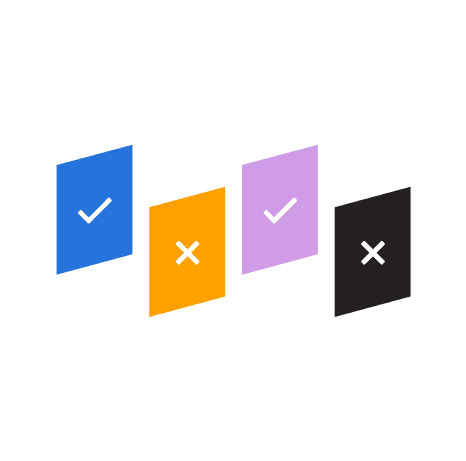What is RFP Automation?
RFP automation is the process of using technology to perform tasks needed to develop, manage, and respond to a request for proposal (RFP).
When a company or a business needs to get a project or a service outsourced, they raise a request for proposal (RFP). This invites service providers or other businesses to offer bids to take up the outsourcing assignment. The RFP includes an array of specifications including things such as the scope of work, skills required, and other compliance issues.
The process of responding to an RFP is a lengthy and tedious one, as it includes everything from evaluating the RFP request to crafting the final RFP response. Preparing an RFP response that meets all needs and requirements is very important for the success of any organization responding to RFPs.
RFP automation helps ease the entire process of RFP response management, from the initial evaluation, through the final creation of a business-winning proposal. By utilizing automation technology, the organization reduces the need for human intervention, decreases time spent on the response process, and lowers the costs associated with it.
RFP management software is used for the automation of RFP responses. This takes the process one step further from being simply an organizational tool and turns it into a streamlined and efficient system that reduces the need for human intervention, reducing errors and saving valuable resources.
There are many parts of an RFP response that are consistent across all the proposal requests raised by a company. This could include a description of the company, corporate contact information, executive summaries, or security and compliance questionnaires. These parts of an RFP response can be recycled and used again and again, instead of starting every response from scratch.
RPF automation helps reduce the repetitive and often mundane tasks associated with RFP responses. It also enables employees to focus on more creative and complex aspects of the project that can add more value to the RFP response.
Over the last decade, there have been dramatic advances in the capabilities of RFP automation systems. Today, RFP automation software applications use natural language processing (NLP), artificial intelligence (AI), and machine learning (ML) to make the automation process smoother and more intuitive.

How do you automate an RFP response?
Automating the RFP response process is a multi-step process that involves stakeholders across an organization working together. The goal of any automation effort is to reduce the amount of manual work required to respond to an RFP or generate a proposal. To that end, automating an RFP response process usually involves three broad steps:
- Adding and organizing content into a central library
- Using machine learning to automate content suggestion and response
- Using collaboration tools and native integrations to streamline workflows.
Adding and organizing content into a central library
An organization’s content library is the heart of its RFP automation efforts. Without a robust and organized content library, any attempts to automate the RFP response process will prove unfruitful and frustrating. For response automation to work, it must pull from a list of previously approved, vetted, and organized content.
While this process can initially feel daunting, in the long run, keeping content stored in a central library improves RFP automation efforts and reduces time spent crafting or searching for content.
To accomplish this goal, teams need to dedicate time to initially populating the central library with previously approved content pieces. Then, as teams respond to RFPs, they should continue storing and tagging all relevant content in the central library. As the library grows, so do the chances for automation.
Many bigger organizations often hire team members specifically to manage and organize content. By investing resources in keeping the content library accurate and up-to-date, the rest of the organization is set up to make the most out automation.
Using machine learning to automate responses
A core component of automation software involves the use of machine learning to suggest relevant answers or content pieces. As mentioned above, to accomplish this, teams need to first have a robust content library full of relevant and approved responses. Once this content library is populated, the automation software scans the initial RFP document and identifies relevant headings, questions, and response sections. Then, the software pulls out relevant answers or content pieces from previously answered RFPs or appropriately tagged and categorized content stored in the library. This process reduces the overall time it takes to respond to an RFP and significantly decreases the amount of manual, time-consuming work needed to respond.
The demand for RFP automation is increasing among proposal teams, experts, and leaders. RFP automation tools optimize the RFP response process and allow team members to dedicate time to strategic and high-value initiatives rather than copying and pasting sections of documents.
These tools do not just help businesses, but also individuals, as they are spared from spending time on repetitive clerical tasks. Instead, automation tools allow them to work on aspects of the business that help them develop their skills, and on tasks that are more satisfying and fulfilling.
With the passing of time and the advancement of technology, RFP automation software and tools are becoming more and more accessible, impactful, and affordable. Using RFP automation can help businesses reduce costs, save time, and optimize outcomes.
Automating question answering
Many of the questions asked in the initial RFP are industry-standard or similar (if not the same) to previous RFPs. As companies routinely respond to RFPs, they’ll likely encounter the same questions repeatedly. Rather than wasting time manually responding to these each time they’re asked, companies can save previous responses and use automation software to automatically answer.
For example, many companies are required to answer complex, but industry standard, security and compliance questions. While responding to these types of security or due diligence questionnaires can be tedious when done manually, automation makes this process simple. Having answered these questions previously, teams can categorize and tag prior responses, allowing their automation software to automatically identify these standard questions and respond with previously approved content.
Use tools to streamline the RFP response process
Another way organizations can further their automation efforts is by streamlining their response process. To accomplish this, RFP automation software usually includes tools for automating tedious and manual steps in the process like reviewing and approval. Organizations can use multi-step workflows to automate various parts of the reviewing process such as automatically notifying SMEs of content due dates, tagging relevant team members for reviews and approvals, and tracking every step of the process to identify future bottlenecks.
These types of automation also have the added benefit of helping team members collaborate more efficiently as they centralize work usually done in multiple products, which saves time and increases overall visibility.

Features of a Good Automation Software
Different RFP automation software comes with different features. However, there are some features that are a must-have in any good automation software.
Automated notifications
The feature of sending automated notifications to stakeholders is very important. It helps to let them know the current stage of an RFP by sending automated notifications and also allows them to know if there are any issues with the process. At the same time, it not only sends notifications about deadlines and timeliness of response to those managing the RFP, but to the individual or company that needs to submit information.
Knowledge sharing
Good automation software allows easy access to information and data by storing all the information in a centralized storage system. Anyone with access to this storage can extract any information needed within minutes instead of manually searching for hours.
Collaborative RFP response development
If there is no clarity in the RFP, or the RFP raised doesn’t match the demands of different stakeholders, it can be frustrating for both the RFP team and the response teams. A good automation tool allows all stakeholders to work on the RFP collaboratively. This helps in clearly defining the RFP’s demands to the vendors and communicating about specific items.
Integrations
Top RFP automation software should have standard third-party integrations so that it can easily integrate with the existing technology and systems of the business. This allows the staff to easily work on the new system.
Does Your Organization Need RFP Automation?
If your business is facing the following problems, it is high time to opt for RFP automation.
- Completing an RFP response takes more time than stipulated, leading to delays in closing deals.
- The RFP management team is forced to simplify the RFP responses and use shortcuts to meet the deadlines, leading to poor-quality RFP responses.
- When manually preparing questionnaires, the response team is asking the stakeholders the same questions over and over.
- The response team is unhappy with their job profile and starts feeling that their career has come to a standstill as they work on the same repetitive tasks over and over.
- The volume of RFP responses required is increasing and managing the processes is becoming impossible.
Benefits of RFP Automation
RFP automation can bring a lot of benefits to a business.
Saves time
RFP automation can lead to dramatically improved staff productivity. It prevents the response team from wasting time on routine tasks when they could be focusing on other important parts of the project like crafting custom-tailored proposals. These tasks take hours to complete manually, but through RFP automation they can be done within minutes, reducing the time of the RFP response process to half.
Increases consistency
A big problem faced in an RFP response process is the compartmentalization of knowledge. Different stakeholders have different ideas and demands from an RFP response and collecting them manually involves a lot of time and effort.
Automation software provides a collaboration option where all stakeholders and the entire procurement team can work together on a given template and share their questions, requirements, and more. Thus, there is more clarity about the exact needs of an RFP response, and consistency is maintained throughout.
Not only this, but automation software increases the consistency of branding, wording, and specifications across all proposals.
Less room for error
As the manual efforts required in mundane and repetitive tasks lessens, so does the room for human error. By automating responses with previously approved content, response teams can ensure that all their content is relevant, up-to-date, and free of grammatical errors.
It also helps to ensure nothing is missed. Given that RFP responses are highly detailed and require consistency and precision, automating the process and including information compiled from previous requests can create a more holistic and thorough document.
Happier employees
When response team members spend less time on boring, repetitive work, they spend more time on productive, creative, and fulfilling assignments. This makes team members feel less like robots and more like experts, resulting in higher engagement and happier workplaces.
Myths About RFP Automation
There are a lot of questions and myths around RFP automation.
Automation tools will replace people
The biggest myth about using automation software is that it will replace humans and take away jobs. Businesses must understand that while an RFP automation tool can help in managing RFPs to an extent, there are many parts of the RFP response process that require a human touch. Tasks like evaluating an RFP, reviewing, customizing, and verifying content are best done by response experts. Automation software works best as a tool to extend the reach of team members rather than replace them, by helping to make their jobs easier.
RFP automation Is expensive
A very common myth around RFP automation software is that most solutions are too expensive and only the big businesses can afford them. The reality is that today, most Software as a Service (SaaS) providers provide comprehensive and affordable subscription models.
Additionally, while initial investments in new software can often feel daunting or expensive, over time the return on investment more than covers these initial costs. As organizations automate their response process, they decrease the time spent on individual responses, increase the number of bids won, and boost their overall ROI. Delaying RFP automation can end up being costlier in the long run for a business, not just in terms of money, but also employee time and other resources.
RFP automation tools have limited features
A general perception is that RFP automation tools can only help with the RFP management work. Not true. Today’s RFP automation tools include a variety of features that make life easier for entire organizations. Features like content and knowledge management, branded templates, software integrations, and workflows help manage the entire process of responding to RFPs, answering due diligence questionnaires, or even creating winning sales proposals and statements of work. In short, the RFP automation software can be used for much more than just managing the RFP process and can be beneficial for a business in more than one way.
RFP automation is critical to success
As the demand for complex and unique RFP responses increases, companies struggle to keep up. With limited time and resources, many companies are forced to strategically decide which opportunities to bid on, losing them potentially valuable future business. However, companies that invest in RFP automation can do more with less, streamlining their response process, saving valuable time, and giving their response teams more chances to win business.
